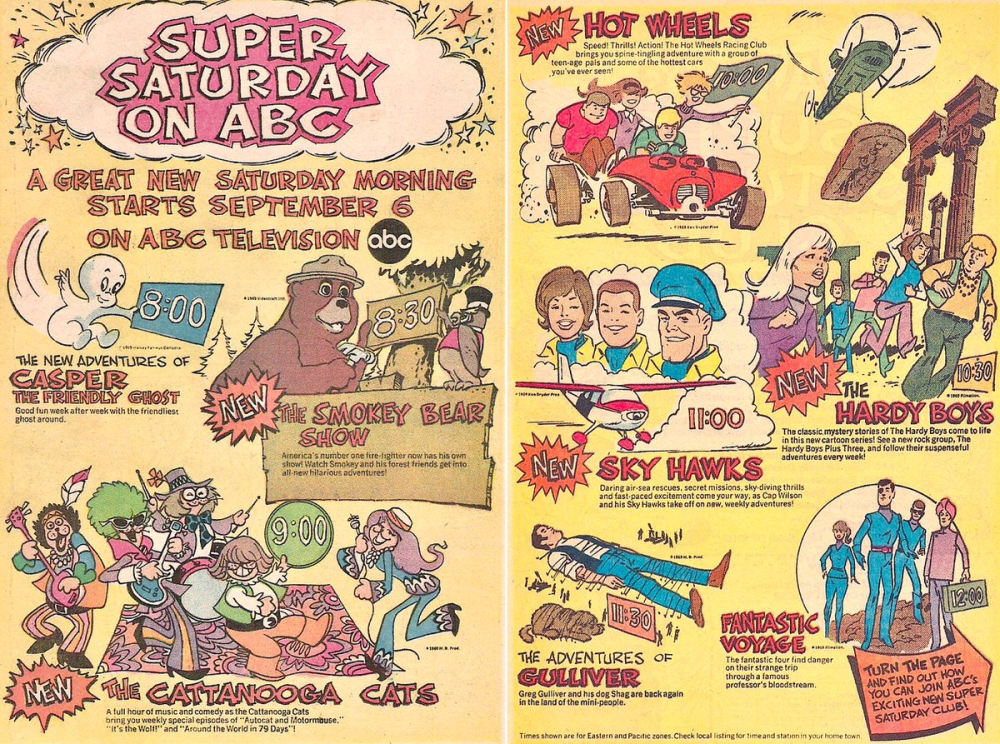
The surprising psychological mechanisms that make forgotten animated adventures resurface decades later in our consciousness

New York, N.Y. – The melody arrives uninvited, threading through the mundane moments of adult life like a paper airplane cutting through office air. “Fun with us being Skyhawks,” the theme song declares with the boundless optimism that only Saturday morning cartoons could muster.
For countless viewers who came of age during the late 1960s and early 1970s, this particular earworm represents more than mere nostalgia—it exemplifies the profound neurological and psychological mechanisms that bind us to our formative media experiences.
Skyhawks, the animated series that aired from 1969 to 1971, followed the adventures of Mike Wilson and his family as they operated a rescue and charter service. Created by Ken Snyder and produced by Pantomime Pictures, the show represented a unique entry in the animation landscape of its era, combining adventure storytelling with aviation themes that captured young imaginations during the height of America’s fascination with flight and space exploration.
The Neurological Architecture of Musical Memory
The persistence of cartoon theme songs in adult consciousness reflects sophisticated neurological processes that scientists have only recently begun to understand. Dr. Daniel Levitin, a cognitive psychologist and neuroscientist at McGill University, explains that musical memories form through multiple neural pathways simultaneously, creating what researchers call “redundant encoding.” When we hear the Skyhawks theme, our brains don’t simply process melody—they integrate rhythm, harmony, lyrics, and associated visual imagery into a complex neurological tapestry.
Memory consolidation occurs most powerfully during childhood and adolescence, when neural plasticity reaches its peak. The developing brain creates stronger synaptic connections for experiences encountered during these formative years, explaining why a cartoon theme heard at age eight resurfaces with startling clarity decades later. This phenomenon, known as the “reminiscence bump,” demonstrates how memories formed between ages 10 and 30 maintain exceptional durability throughout the human lifespan.
The auditory cortex processes musical information differently than other sensory input, routing signals through the hippocampus and amygdala—brain regions responsible for memory formation and emotional processing. This explains why hearing “Fun with us being Skyhawks” doesn’t merely trigger recall; it evokes the entire emotional landscape of Saturday morning television viewing, complete with sensory details about breakfast cereals, pajamas, and the particular quality of weekend morning light.

Cultural Context and Generational Identity
Skyhawks premiered during a pivotal moment in American culture, when aviation represented both technological prowess and adventurous spirit. The Apollo program dominated headlines, military aviation played prominent roles in ongoing conflicts, and commercial air travel was expanding rapidly. For children of this era, flight symbolized limitless possibility—a theme that resonated through both the show’s content and its memorable musical accompaniment.
The cartoon’s production values reflected the television industry’s evolving approach to children’s programming. Unlike the theatrical shorts that had dominated earlier decades, Skyhawks was created specifically for television broadcast, with animation techniques optimized for smaller screens and home viewing environments. The show’s 17-episode run may seem brief by contemporary standards, but its syndication ensured continued exposure across multiple generations of viewers.
Generational identity forms partly through shared media experiences, and cartoon theme songs serve as unofficial anthems for specific age cohorts. Those who remember Skyhawks likely also recall Jonny Quest, The Jetsons, and Scooby-Doo—shows that collectively defined Saturday morning television culture during the late 20th century. These programs created a common vocabulary of references, musical phrases, and visual imagery that continues to unite viewers decades after their original broadcasts.
The Psychology of Involuntary Musical Imagery
Involuntary musical imagery (INMI), commonly known as “earworms,” affects approximately 98% of the population according to research conducted by Dr. Kelly Jakubowski at Durham University.

These spontaneous musical recollections typically last between 15 and 30 seconds and occur most frequently during periods of reduced cognitive load—precisely the mental states that characterize routine adult activities like commuting, exercising, or performing household tasks.
The Skyhawks theme possesses several characteristics that enhance its potential for involuntary recall. Its melody follows a simple, repetitive structure that cognitive scientists call “high cognitive availability.”
The lyrics combine concrete imagery (“Skyhawks”) with abstract concepts (“fun”), creating semantic associations that multiple retrieval cues can trigger.
‘The song’s moderate tempo and major key signature align with research findings suggesting that upbeat, moderately complex melodies have the highest likelihood of spontaneous recurrence.
Priming effects also contribute to theme song resurgence. Environmental triggers—aircraft overhead, vintage television programming, conversations about childhood—can activate neural pathways associated with Skyhawks memories. Once activated, these pathways may continue firing long after the initial stimulus disappears, resulting in the persistent musical loop that characterizes earworm experiences.
Modern Implications and Digital Preservation
Contemporary media consumption patterns differ dramatically from the appointment television viewing that characterized the Skyhawks era. Today’s audiences access content on demand, often consuming entire series in compressed timeframes that limit the repetitive exposure necessary for deep memory consolidation.

This shift raises questions about whether current programming will generate the same long-term recall experienced by Skyhawks viewers.
Digital preservation efforts have given classic cartoons new life, with streaming platforms and video sharing services making previously unavailable content accessible to contemporary audiences.
YouTube channels dedicated to vintage animation have introduced Skyhawks to viewers who never experienced Saturday morning television culture, creating new neural pathways for musical memories in different generational contexts.
The phenomenon of cartoon theme song persistence demonstrates the remarkable durability of childhood media experiences and their continued influence on adult consciousness. When “Fun with us being Skyhawks” surfaces unexpectedly in our mental soundscape, it represents more than simple nostalgia—it reveals the sophisticated ways our brains preserve, process, and randomly access the cultural artifacts that shaped our formative years.
Understanding why these musical memories persist offers insights into human cognition, cultural identity, and the lasting power of seemingly ephemeral entertainment. The next time that familiar melody takes flight through your thoughts, remember that you’re experiencing a complex neurological phenomenon that connects you to both your personal history and a broader community of viewers who shared the same Saturday morning adventures decades ago.
Memory’s Flight Path: Why Childhood Cartoons Echo Through Adult Minds (Sept. 12, 2025)
Audio Summary
This feature explores why the theme song from the 1970s cartoon Skyhawks spontaneously resurfaces in adult minds decades after viewing. The article examines neurological mechanisms of musical memory, cultural context of aviation-themed entertainment, and psychological factors behind involuntary musical imagery. Drawing from cognitive science research, it explains how childhood media experiences create lasting neural pathways that randomly activate throughout adult life, demonstrating the profound connection between formative entertainment and long-term memory formation.